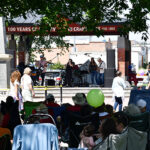Home »
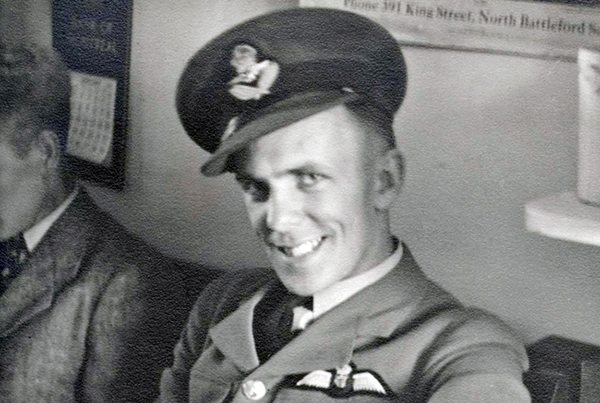
RCAF sent the wrong Jim Milne overseas
By Elinor Florence
 Now 97, air force veteran Jim Milne lives with his wife Betty in a lovely apartment in Invermere, British Columbia.
Now 97, air force veteran Jim Milne lives with his wife Betty in a lovely apartment in Invermere, British Columbia.
Jim is still as sharp as a tack, much like his brother-in-law Ben Scaman of Banff, a Spitfire pilot whom I wrote about here.
The two men married the beautiful Amundsen sisters of Claresholm, Alberta, Audrey and Betty, and that’s how they became both friends and family members.
They have something else in common. “Ben is just 10 days older than me, and we’re in a competition to see who’s going to reach the Double-O,” Jim laughed, referring to their 100th birthdays coming up in 2020.
Both men also served in the Royal Canadian Air Force during the Second World War, although their experiences were quite different. Ben went off to face the enemy, while Jim reluctantly remained at home.
The Early Years
James Fraser Milne was born in Winnipeg on February 3, 1920. His father David Milne was a Scottish immigrant who worked as a salesman; his mother Louise was a farm girl from rural Manitoba. Jim was an only child. “My parents recognized perfection,” Jim explained with a twinkle in his eye.
 The clever young man finished high school and enrolled in the University of Manitoba to study geology. Like so many others, his plans were interrupted by Hitler.
The clever young man finished high school and enrolled in the University of Manitoba to study geology. Like so many others, his plans were interrupted by Hitler.
Jim Joins the Air Force
On April 12, 1942, Jim left university and joined the RCAF with the same ambition as many others: to become a pilot and attack the enemy. He did his basic training in Brandon, Manitoba; his first level Initial Training School in Regina; and his second level Elementary Flight Training School in Virden, Manitoba.
While in Regina, Jim saw the most startling feat of flying he has ever seen: three Tiger Moths flying in formation, backwards! “There was a very strong wind and I can only guess they were doing it deliberately,” Jim recalled.
In spite of the rule about not taking photographs on air bases, Jim managed to collect a few of them.
On January 11, 1943 he was sent to Claresholm, Alberta, to complete the third and final stage of his training: Service Flight Training School. One of the most common aircraft used for training was a Cornell.
 Every new group of flyers in Claresholm was given a welcome dance, and that’s where he met his future wife Betty. “It was a jitney dance – you had to pay 10 cents to dance with the partner of your choice,” he said.
Every new group of flyers in Claresholm was given a welcome dance, and that’s where he met his future wife Betty. “It was a jitney dance – you had to pay 10 cents to dance with the partner of your choice,” he said.
Jim’s Hopes Shattered
The budding courtship was cut short when Jim finished his course and went on to Rivers, Manitoba on June 10, 1943. From there, he received his long-awaited orders to head overseas to fight the enemy. He made it as far as Halifax, and was preparing to board the troop ship when the Public Address system called him to the administration office.
“The plans have changed,” he was told. “You’re being sent back to Rivers, Manitoba to become a Flight Navigation instructor.”
Baffled and frustrated, the young man got back on the train and returned to Manitoba. “The air force didn’t bother explaining anything,” he said. “You just followed orders and did as you were told.”
After a couple of months, he was posted to Calgary on August 14, 1943. There he ran across someone who had been working in Halifax at the time, and he explained to Jim what had happened.
It was another pilot named James Milne who had requested a home posting because his wife was expecting a baby, and the RCAF had confused the two men! “I never knew what happened to the other guy,” Jim said. “He probably went overseas in my place.”
There was one advantage to the Calgary posting, however. Betty was also in that city, taking a business course at Mount Royal College and rooming with her sister Audrey.
Jim Trains Flyers How to Navigate
Jim instructed the men who were in their final stage of training at Service Flight Training Schools. “They knew how to fly,” he explained. “Now they needed to learn how to get around the country, and how to get home again. Essentially, I taught them how to read a map.”
This photo shows the interior of an Avro Anson at Claresholm, where flyers practised their skills.
 In the classroom, Jim briefed the men on how to recognize rivers, railways, and towns from the air. I asked him if the old story about flying low to check the names on grain elevators was true, and he confirmed it was indeed! If a pilot got lost, he headed for one of the distinctive grain elevators that dotted the prairies and checked to see which town he was flying over.
In the classroom, Jim briefed the men on how to recognize rivers, railways, and towns from the air. I asked him if the old story about flying low to check the names on grain elevators was true, and he confirmed it was indeed! If a pilot got lost, he headed for one of the distinctive grain elevators that dotted the prairies and checked to see which town he was flying over.
In Canada, finding their way around was still relatively easy. “Of course, it was a different situation when they got to England,” Jim said. “Over there the landscape was a real hodgepodge.”
Contributing to their difficulty overseas, a full blackout was in effect so the men couldn’t navigate by watching for the lights of the towns below. Therefore learning how to fly using instruments was of vital importance.
Over the next few years, Jim continued to request an overseas posting but was told his skills as an instructor were more valuable at home.
Ten months later, in May 1944, Jim was sent to North Battleford. He and Betty were engaged by then, and they wed in her home town of Claresholm on August 1, 1944. Betty came from a family of ten siblings, so Jim joined a large extended family.
“It was a scorcher,” Betty recalls. “Jim had coloured confetti all down his back inside his white shirt, and when he undressed that night the sweat had caused coloured polka dots all over his bare skin!” The happy couple spent a few days at Jim’s family cabin at Clear Lake, Manitoba before taking up their new home in North Battleford.
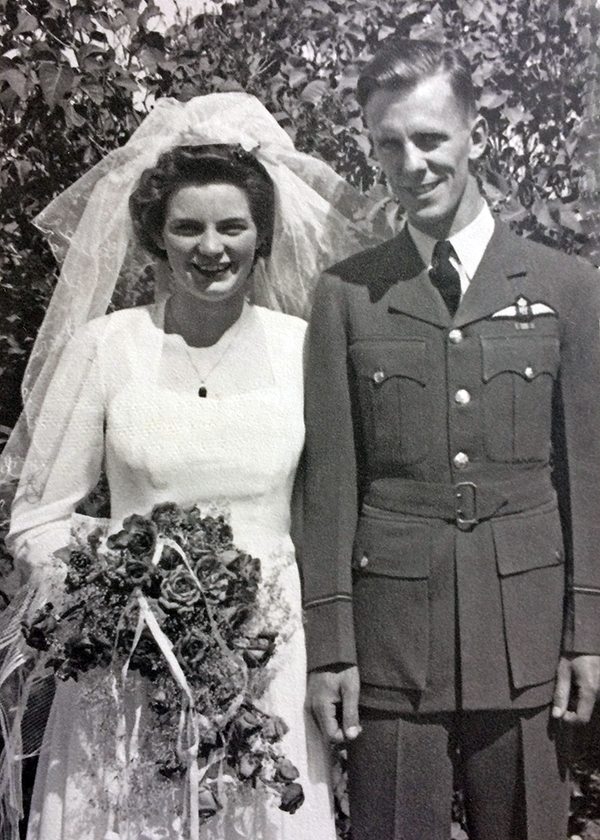 Married quarters were not provided, so the couple had to find their own accommodation. They boarded with a family in town, and for the first time in their lives, they were bitten by bedbugs! However, they persevered.
Married quarters were not provided, so the couple had to find their own accommodation. They boarded with a family in town, and for the first time in their lives, they were bitten by bedbugs! However, they persevered.
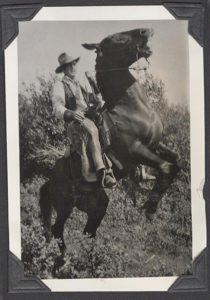 While in North Battleford, Jim collected a few more interesting photos. A neighbouring farmer made some extra cash lending out his horse to the airmen, so they could take photos and send them home to their admiring families.
While in North Battleford, Jim collected a few more interesting photos. A neighbouring farmer made some extra cash lending out his horse to the airmen, so they could take photos and send them home to their admiring families.
Betty stayed in North Battleford when Jim was sent back to Rivers for a month, and then to Portage La Prairie for two months.
The lead image above shows Jim seated in a barber shop in North Battleford, waiting his turn for a haircut.
In June 1945, the war in Europe ended. However, there was no indication if and when Japan would surrender, so the air training plan was still opening new air bases. Jim was dispatched to the new base in Souris, Manitoba, and Betty went with him. The couple lived in one room until that happy day when Japan surrendered and the Second World War came to its final conclusion.

Jim Shows Artistic Skills
One of the most unusual wartime souvenirs I have seen is Jim’s lengthy logbook, in which he records almost 2,000 hours of flying time.
It is adorned with the most intricate sketches, although Jim hastened to tell me they weren’t all original. “Every station used to put out a little magazine, so I copied some of them,” he explained. Nevertheless, they seem to indicate a certain amount of artistic talent, not to mention a sense of humour.
This sketch done while Jim was in Claresholm, Alberta, is of Percy Prune, a popular air force cartoon character who got into all kinds of trouble.
 This sketch made by Jim Milne when he was training at Virden, Manitoba in November 1942 reveals a very nervous young pilot.
This sketch made by Jim Milne when he was training at Virden, Manitoba in November 1942 reveals a very nervous young pilot.
 However, just one month later, this sketch shows that he had acquired a lot more confidence.
However, just one month later, this sketch shows that he had acquired a lot more confidence.
 This sketch shows that the weather didn’t always cooperate.
This sketch shows that the weather didn’t always cooperate.
 Jim was obviously pleased to have this note from his Chief Instructor, saying that he was “Proficient on Anson Aircraft.”
Jim was obviously pleased to have this note from his Chief Instructor, saying that he was “Proficient on Anson Aircraft.”
 And like every other flyer, Jim was thrilled when the war ended in August 1945.
And like every other flyer, Jim was thrilled when the war ended in August 1945.
Jim remained in the RCAF reserve for several years after being discharged on October 12, 1945. With financial aid from the federal government, Jim returned to complete his geology degree at the University of Manitoba. “That’s when life got interesting,” he said.
He may not have gotten overseas during the war, but now he pursued a career with Gulf Oil, working in Iran, Nigeria, Cameroon, Kuwait, and Norway.
For the most part, Betty remained at home in Calgary, raising their four children: Carol, born in 1946; Julie born in 1948; Wendy, born in 1951 (tragically, Wendy died of breast cancer at the age of 33); and Dave, born in 1954.
When their youngest child Dave started university and left home, Jim and Betty spent two years living in London, England, where Jim worked at Gulf Oil’s head office.
Having owned a cabin at Lake Windermere since 1952, they soon sold their house in Calgary and moved to Invermere full-time in 1985.
They have many friends in the community. They also have six grandchildren and seven great-grandchildren. Jim and Betty Milne just celebrated their seventy-third wedding anniversary!
Jim Milne is one of 74 valley veterans featured in the new Honour Our Veterans hanging banner program, each banner showing the name and photograph of a wartime veteran.
Here Sandi Jones and I visited Jim Milne at his home to show him the banner sponsored by his family. For more information on the Honour Our Veterans banner program, read this earlier article in e-KNOW.
This Remembrance Day, let us remember not only the men, but hundreds of thousands of Canadian men and women who provided essential support here at home. Jim Milne, thank you for your service to our country!
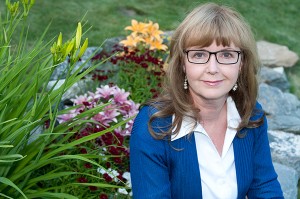
– Career journalist and bestselling author Elinor Florence of Invermere has written two wartime books. Her novel Bird’s Eye View tells the story of an idealistic Saskatchewan farm girl who joins the Royal Canadian Air Force and becomes an interpreter of aerial photographs. My Favourite Veterans is a non-fiction collection of interviews whose stories appeared previously on e-KNOW, including Cranbrook’s own Bud Abbott.
Elinor’s new novel Wildwood, about pioneer life in the Peace River, Alberta region, will appear in February 2018. It is available for pre-order now at a reduced price on Amazon. For more information about all three books, visit Elinor’s website at www.elinorflorence.com or call her at 250-342-1621.








